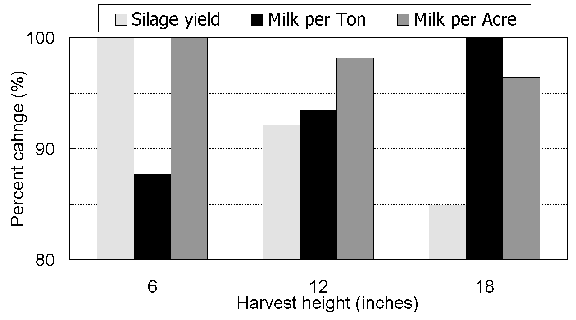
Cutting Height Yield And Quality Trade-Off For Corn Silage
August 6, 1998 5(20):115-116
Joe Lauer, Corn Agronomist
Increasing the cutting height of corn silage will obviously decrease silage yield.
But, what happens to silage quality as the cutter bar is raised? Corn plant parts
differ for the amount of fiber and digestible energy. Raising the cutter bar on
a silage chopper will leave in the field more of the lower corn stalk that is typically
higher in fiber and lower for digestible energy. Most of the energy and value (quality)
of corn silage is in kernels on the ear.
Figure 1 shows the yield and quality trade-off that exists for yield, milk per ton
and milk per acre. Milk per ton is a quality estimate for corn silage that is based
on equations predicting intake and animal requirements from data derived from National
Research Council (NRC) tables on nutrient requirements of dairy cattle (1978, 1989).
Milk per ton approximates a balanced ration meeting animal energy, protein, and
fiber needs based on forage quality (in vitro digestibility basis). Milk
per ton is based on a standard cow weight and level of milk production (1350 lb.
body weight and 90 lb/d at 3.8% fat). Both milk per acre and milk per ton was calculated
using a model derived from the spreadsheet entitled, "MILK95," (Undersander
et al., 1993). Milk per acre is simply milk per ton multiplied by yield.

Corn silage yield decreased 15% as the cutter bar was raised from 6 to 18 inches
above the soil surface. Milk per ton was lowest at a cutter bar height of six inches
and greatest at a cutter bar height of 18 inches. So even though silage yield decreased
15% by raising the cutter bar 12 inches, silage quality (milk per ton) increased,
and only a 3-4% milk per acre reduction was observed. Additionally more beneficial
crop residue would be left in the field without sacrificing much milk per acre.